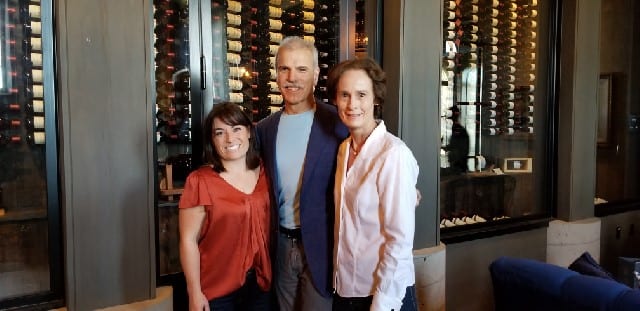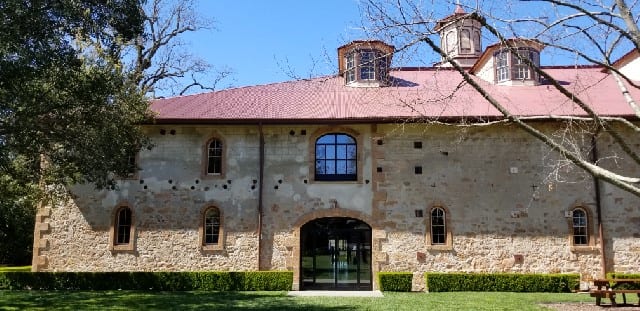
01 May Mondavis celebrate 75 years at Krug Winery in Napa Valley
This story originally appeared in the Napa Valley Register.
There are only three family-owned wineries remaining in the Napa Valley that have been owned continuously by the same family since World War II. One of these wineries is Charles Krug Winery, celebrating their 75th anniversary this year. (The other two wineries are Sutter Home and Nichelini Family Winery.)
The Mondavi family bought the Charles Krug Winery in 1943, but the winery pre-dates them. Charles Krug, born in Prussia, was educated as a journalist who first came to the United States to give a talk at the Philadelphia University of Free Thinkers. He later returned to the U.S., moving to San Francisco where he published a radical newspaper, as well as worked at the U.S. Mint.
Wine became a hobby after Krug was introduced to it by friends who were making wine. In December 1860, Krug married Carolina Bale who came from a prominent family. As part of her dowry, he was given 600 acres in what is today St. Helena. Due to his love of wine, Charles Krug established a winery in the heart of the 600 acres in 1860, making it the oldest winery in the Napa Valley.
Cesare and Rosa Mondavi emigrated from Italy in 1908. First established in Minnesota, Cesare started a wine grape shipping venture in 1919 and saw the potential of wine. By 1922, Cesare and Rosa moved the family to Lodi and built a business, shipping wine to the northeast where there was a concentration of wine-drinking immigrants. In the middle of World War II, Cesare and Rosa Mondavi purchased the Charles Krug Winery, and the Mondavi legacy was born.
Peter Mondavi Sr., the fourth child of Cesare and Rosa, graduated from Stanford with a degree in economics in 1938. With an interest in wine, he took graduate classes in chemistry at UC Berkeley. Peter Sr. loved wine and experimenting with trials. He was fascinated by the effect of water temperature on still wine during fermentation and conducted revolutionary research on cold fermentation.
His findings enabled the production of crisp, fruity white wines and rose wines, which became the industry standard. Peter Sr. introduced French oak barrels for aging wine in 1963, citing their superior quality to American oak. For more control over the winemaking process, he introduced glass-lined tanks.
Peter Sr. believed in single-varietal wines and Charles Krug was one of the first California producers to label wines by varietal. He also believes in low-alcohol wines and used to say that too much alcohol in wine meant that you could not enjoy the wine with dinner, nor could you drive home afterwards.
Today, Charles Krug Winery is run by third-generation brothers Peter Mondavi Jr. and Marc Mondavi, as well as fourth-generation members of the Mondavi family. Angelina, Alycia, Riana and Giovanna (Marc’s children) and Lucio and Lia (Peter Jr.’s children) are all involved in carrying-on the traditions and legacy established by Peter Sr., while also shaping the future of the winery. Angelina, a winemaker, and Lucio are both winery board members. Riana handles national restaurant chain relationships. Giovanna, who works in finance, and Lia, who is still at college, both serve as brand ambassadors in the Boston area. Alycia is a marketing consultant and brand ambassador and represents the winery onsite and at events.
In honor of the anniversary, the Mondavi family opened their coveted collection of Vintage Selection offerings, crafted from the best blocks of the family’s best vineyards. Dating back to 1944, the year after the Mondavi family acquired Charles Krug, it may be the oldest near-continuous library of Cabernet Sauvignon in Napa Valley.
The library tasting showcased the following vintages: 1964, 1966, 1974, 1983, 1991, 1998, 2003, 2015 and a barrel sample of 2016. The stand-outs for me were the older wines that have aged gracefully. The 1964 is a brick red color that reminded me of walking into an attic. There are aromas of cedarwood, sandalwood, orange skin, a touch of cherry and dried spice. 1966 is also a brick red color with notes of spice, coffee and caramelized burnt orange and still vibrant acidity. The 1974 with bright floral, coffee and wood notes is elegant and a fresh despite its 45-year age. The 1983 is a deep red color with notes of wild raspberry, blackberry, violet and dried herbs and still-present tannins.
The influence of Peter Mondavi Sr. is evident in the wines pre-dating 2000. A big proponent of single varietal wines, until 2003 the Vintage Select Cabernet Sauvignon are 100 percent Cabernet Sauvignon. However, after many years, and after Marc Mondavi created the Reserve Generations Red, a Bordeaux blend, Peter Sr. agreed to blending and 2003 marked when additional varieties were added.
Another noticeable difference is in the alcohol in the wines, which has progressively increased over the years. The 1964 is only 11.4 percent whereas the 2015 is 15.8 percent. Peter Sr. believed in low-alcohol wines, but the increase is partially a result of healthier vines that reach their flavor profiles, naturally resulting in higher alcohol. Regardless of the alcohol level, the intention in Charles Krug wines is to find balance.
Tasting old vintages of wine is a special treat that not everyone gets to experience. But Charles Krug is making it possible. They are releasing the first commercial library release in honor of the 75th anniversary, which will include bottles from 1974, 1991 and 2003. The 1991 has notes of lavender and black fruit and fills the mouth with soft acid and tannins. The 2003, which has five percent Petit Verdot, four percent Merlot, two percent Cabernet Franc and one percent Syrah, has deep red and black fruit and fresh olive notes, as well as integrated acid and tannins.
Seventy-five years later, one of the most important values of the Mondavi family is family, and they are proud to still be family-owned and -operated. Fourth-generation Alycia Mondavi, daughter of Marc Mondavi, was born and raised on the property and explained that in the family that somehow, they all end up in wine. “It is hard to deviate,” Alycia explained. “It is in our blood.”
Read the original story in the Napa Valley Register.
Discover more from Please The Palate
Subscribe to get the latest posts sent to your email.





